剑桥雅思9:Test4雅思阅读PASSAGE2真题+答案+解析
发布时间:2021-06-29 关键词:剑桥雅思9:Test4雅思阅读PASSAGE2READING PASSAGE 2
You should spend about 20 minutes on Questions 14- -26 which are based on ReadingPassage 2 below.
Young children's sense of identity
A Asense of self develops in young children by degrees. The process can usefully bethought of in terms of the gradual emergence of two somewhat separate features:the. self as a subject, and the self as an object. William James introduced the distintionin 1892, and contemporaries of his, such as Charles Cooley, added to the developingdebate. Ever since then psychologists have continued building on the theory.
B According to James, a child's first step on the road to self-understanding can
be seen as the recognition that he or she exists. This is an aspect of the self thathe labelled 'self-as· -subject', and he gave it various elements. These included anawareness of one's own agency (i.e. one's power to act), and an awareness of one'sdistinctiveness from other people. These features gradually emerge as infants
explore their world and interact with caregivers. Cooley (1902) suggested thatasense of the self-as-subject was primarily concerned with being able to exercisepower. He proposed that the earliest examples of this are an infant' 's attempts tocontrol physical objects, such as toys or his or her own limbs. This is fllowed byattempts to affect the behaviour of other people. For example, infants learn thatwhen they cry or smile someone responds to them.
c Another powerful source of information for infants about the effets they canhave on the world around them is provided when others mimic them. Many
parents spend a lot of time, particularly in the early months, copying their infant'svocalizations and expressions. In addition, young children enjoy looking in mirrors,where the movements they can see are dependent upon their own movements.
This is not to say that infants recognize the reflection as their own image (a laterdevelopment). However, Lewis and Brooks Gunn (1979) suggest that infants'
developing understanding that the movements they see in the mirror are contingenton their own, leads to a growing awareness that they are distinct from other people.This is because they, and only they, can change the reflection in the mirror.
D This understanding that children gain of themselves as active agents continuesto develop in their attempts to co-operate with others in play. Dunn (1988) pointsout that it is in such day-to-day relationships and interactions that the child'sunderstanding of his- or herself emerges. Empirical investigations of the self-as-subject in young children are, however, rather scarce because of dififilties of
communication: even if young infants can reflect on their experience, they certainlycannot express this aspect of the self directly.
E Once children have acquired a certain level of self- awareness, they begin to
place themselves in a whole series of categories, which together play such an
important part in defining them uniquely as 'themselves". This second step in thedevelopment of a full sense of self is what James called the 'self-as object'. This hasbeen seen by many to be the aspect of the self which is most influenoed by socialelements, since it is made up of social roles (such as student, brother, colleague) andcharacteristics which derive their meaning from comparison or interaction withother people (such as trustworthiness, shyness, sporting ability).
F Cooley and other researchers suggested a close connection between a person's ownunderstanding of their identity and other people's understanding of it. Cooley
believed that people build up their sense of identity from the reactions of othersto them, and from the view they believe others have of them. He called the self-as-object the looking-glass self", since people come to see themselves as they arereflected in others. Mead (1934) went even further, and saw the self and the socialworld as inextricably bound together: 'The self is essentially a social structure, andit arises in social experience ... it is impossible to conceive of a self arising outsideof social experience.'
G Lewis and Brooks-Gunn argued that an important developmental milestone isreached when children become able to recognize themselves visually without thesupport of seeing contingent movement. This recognition occurs around theirsecond birthday. In one experiment, Lewis and Brooks -Gunn (1979) dabbed somered powder on the noses of children who were playing in front of a mirror, and thenobserved how often they touched their noses. The psychologists reasoned that ifthe children knew what they usually looked like, they would be surprised by theunusual red mark. and would start touching it. On the other hand, they found thatchildren of 15 to 18 months are generally not able to recognize themselves unlessother cues such as movement are present.
H Finally, perhaps the most graphic expressions of self- awareness in general canbe seen in the displays of rage which are most common from 18 months to 3
years of age. In a longitudinal study of groups of three or four children, Bronson(1975) found that the intensity of the frustration and anger in their disagreementsincreased sharply between the ages of 1 and 2 years. Often, the children's
disagreements involved a struggle over a toy that none of them had played withbefore or after the tug-of-war: the children seemed to be disputing ownership ratherthan wanting to play with it. Although it may be less marked in other societies, thelink between the sense of 'self' and of 'ownership' is a notable feature of childhoodin Western societies.
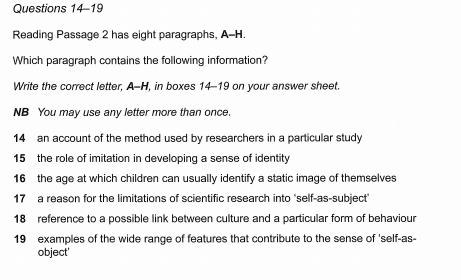
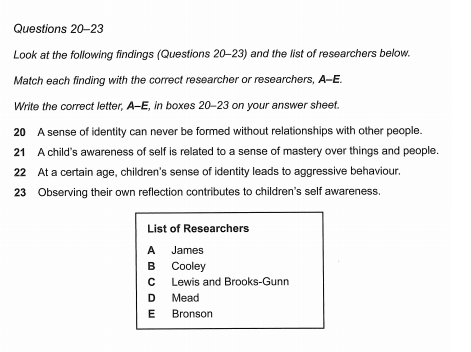

剑桥雅思9阅读真题答案:
Question 14—19:G、C、F、D、H、E
Question 20—23:D、B、E、C
Question 24—26:mirror、communication、ownership
剑桥雅思9Test4阅读Passage2答案解析
体 裁 议论文
题 材 学术研究
主 题 幼儿的身份意识
段落概括 A段 背景介绍:简要介绍幼儿的自我意识的特征及与之相关理论的由来
B段 小孩自我认识的步
C段 通过他人模仿和镜中反射的自我认识
D段 幼儿作为主体的实证研究不足
E段 自我意识发展的第二步——自我作为客体
F段 自我与他人、自我与社会关系的研究
G段 刘易斯和布鲁克斯—冈恩的研究发现
H段 生动的自我意识表达通过愤怒来表现
考题精解
Questions 14-19
题型:配对题MATCHING
解析:本题型为段落信息配对题,命题的两大特点为:彻底同义替换和乱序。所以,应从理解段落入手,而不是按照题目顺序来寻找答案。同时,留意题目要求中是否有NB信息,这意味着是否有段落会被复选。
14.

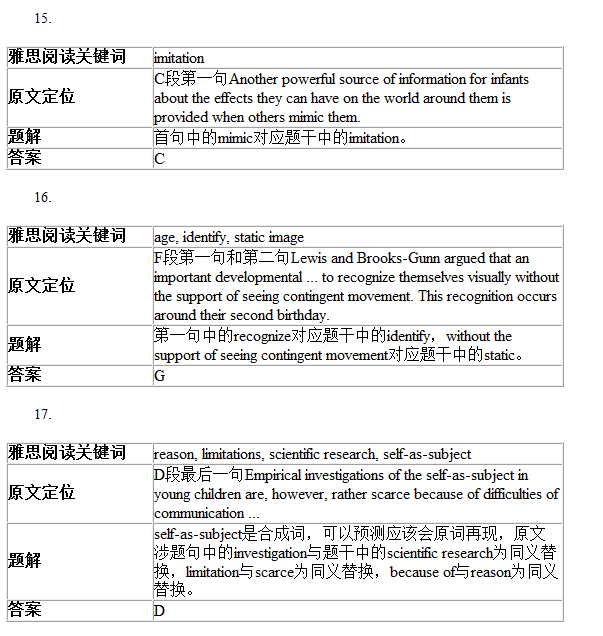
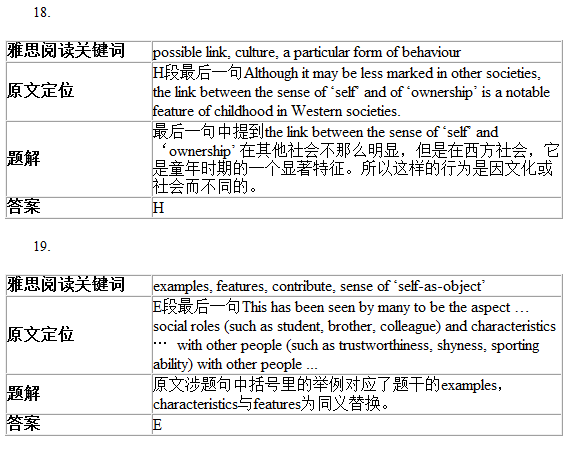
Questions 20-23
题型:配对题MATCHING
解析:人名理论配对题的特点是乱序和同义替换。首先,根据人名去原文中定位,找到其提出的理论(大多数在宾语从句中),然后判断哪些理论与题目中的理论形成同义替换,从而进行配对。
20.

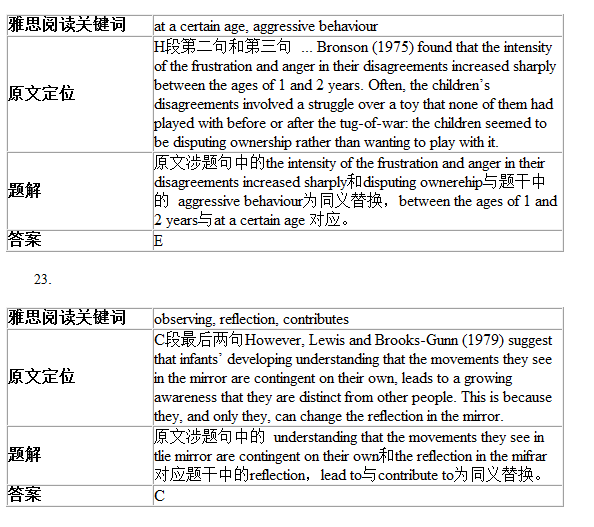
Questions 24-26
题型:摘要填空题SUMMARY COMPLETION
解析:本题型为摘要填空题,答案一般是在原文中复现。做题的时候弄清楚空格词与周围词的搭配关系,判断空格词的词性,同时划出定位词尤其是特殊定位词,便于迅速找出题千所对应的原文位置。填空题要注意答案的字数要求。
24.
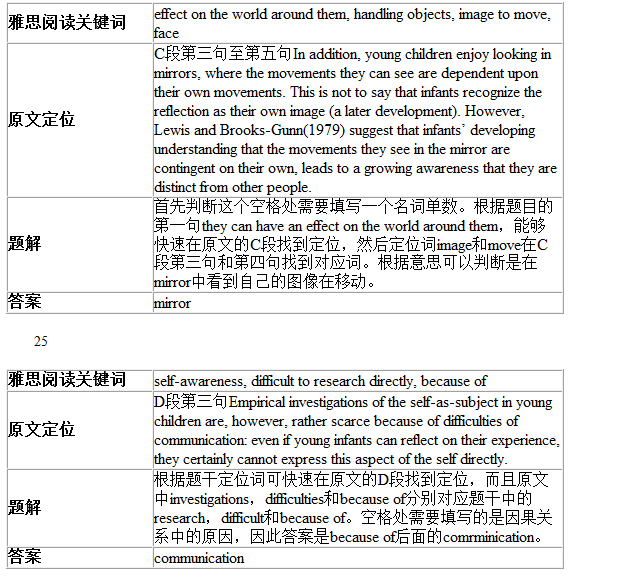

剑9阅读难句解析
1. However, Lewis and Brooks-Gunn (1979) suggest that infants’ developing understanding that the movements they see in the mirror are contingent on their own, leads to a growing awareness that they are distinct from other people.
解析: suggest的后面是that引导的宾语从句,在宾语从句中,主干是infants’ developing understanding leads to a growing awareness。而infants’ developing understanding 的后面则是that引导的同位语从句用来解释understanding的内容,即,the movements ... are contingent on their own。 在同位语从句中,the movements they see in the mirror又是定语从句,the movements在定语从句中作宾语,所以关系代词that可以省略。
参考翻译:然而,刘易斯和布鲁克斯-冈恩( 1979年)表明,婴幼儿逐渐了解到,他们在镜子里所看到的移动其实是取决于他们自己的移动,这种了解导致他们越来越意识到他们是有别于其他人的。
2. This has been seen by many to be the aspect of the self which is most influenced by social elements, since it is made up of social roles (such as student, brother, colleague) and characteristics which derive their meaning from comparison or interaction with other people (such as trustworthiness, shyness, sporting ability).
解析:行主句的后面出现了which引导的定语从句,然后是since引导的原因状语从句,在原因状语从句中,social roles和characteristics是并列关系,characteristics作为先行词,由关系代词which引导的定语从句对其进行解释说明。
参考翻译:许多人巳经看到,这方面的自我受到了社会因素的影响,因为它是由社会角色(如学生,兄弟,同事)以及通过比较或与他人互动派生出的特点(如诚信, 害羞,运动能力)而构成。




